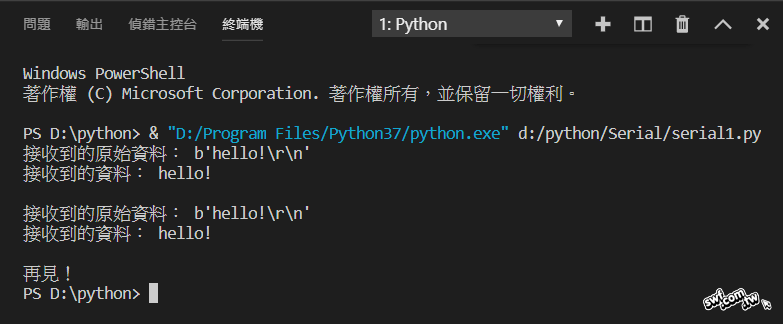Python Serial.readuntil - 4 examples found. These are the top rated real world Python examples of serial.Serial.readuntil extracted from open source projects. You can rate examples to help us improve the quality of examples. Python Serial.writeTimeout - 1 examples found.These are the top rated real world Python examples of serial.Serial.writeTimeout extracted from open source projects. You can rate examples to help us improve the quality of examples. Read (length, timeout=None) source ¶ Read up to length number of bytes from the serial port with an optional timeout. Timeout can be positive for a timeout in seconds, 0 for a non-blocking read, or negative or None for a blocking read that will block until length number of bytes are read. Default is a blocking read.
Download the Serial Example: DSIPythonEX (zipped .py)
After python and the pyserial module has been installed on your system, this example code will send connect, send, and receive commands from our products:
# for PYTHON 3+ with pySerial module installed# DS INSTRUMENTS 2017 PYTHON SCPI REMOTE CONTROL EXAMPLE

import serial # use the serial module (https://pypi.python.org/pypi/pyserial)
import time # delay functions
badCommandResponse = b'[BADCOMMAND]rn’ # response if a command failed (b makes it into bytes)
ser = serial.Serial(“COM79”, 115200, timeout=1) #Change the COM PORT NUMBER to match your device
if ser.isOpen(): # make sure port is open
print(ser.name + ‘ open…’) # tell the user we are starting
ser.write(b’*IDN?n’) # send the standard SCPI identify command
myResponse = ser.readline() # read the response
print(b’Device Info: ‘ + myResponse) # print the unit information

time.sleep(0.1) # delay 100ms
ser.write(b’PHASE?n’) # try asking for phase
myResponse = ser.readline() # gather the response
if myResponse != badCommandResponse: #is this is not a phase shifter why print the error
print(b’Phase=’ +myResponse)
time.sleep(0.1) # delay 100ms
ser.write(b’FREQ:CW?n’) # try asking for signal generator setting

myResponse = ser.readline() # gather the response
if myResponse != badCommandResponse: # is this is not a signal generator why print the error
print(b’Frequency=’ + myResponse)
time.sleep(0.1) # delay 100ms
ser.write(b’ATT?n’) # try asking for step attenuator setting
myResponse = ser.readline() # gather the response
if myResponse != badCommandResponse: # is this is not an attenuator why print the error
print(b’Attenuation=’ + myResponse)
Python Serial Timeout Example Documentation
time.sleep(0.1) # delay 100ms
ser.write(b’FREQ:CW 3GHZn’) #lets change a setting now!
--D. Thiebaut (talk) 13:45, 21 April 2014 (EDT)
The purpose of this tutorial is to illustrate the basic steps required to build a Python module that can be used as a PySerial replacement while developing a Python application that interfaces with an Arduino. The module presented here supports the basic PySerial functions one needs to call from a Python app to talk to an Arduino. These functions, however, either do not do anything, or return canned and predefined data.
|
First we look at how the real PySerial module behaves when supporting a Python program that interacts with an Arduino. We pick several examples from the PySerial documentation.
These examples of a real PySerial program are taken from http://pyserial.sourceforge.net/shortintro.html, and are reproduced below for completeness:
Example 1
Example 2
Python Serial Timeout Example Python
Example 3
Example 4
So, all we have to do is create a module called fakeSerial.py that will contain
- a class called Serial() that can be initialized with various amount of arguments
- a member variable of this class should be called name and return the name of a port.
- a method called write( ) which receives a string and passes it to the fake Arduino
- a method called read() which will read some number of bytes from the Arduino
- a method called close() that closes the port and make all further operations with the Arduino impossible.
- a method called isOpen() which will return True or False depending on whether the port to the fake Arduino is opened or closed.
- a method called readline() that will return characters until a n is found.
Below is our first attempt at building this module.
Python Serial Time Out Example Paragraph
Below is our test program that uses the simulator and runs the same tests we listed at the top of the page. Note that the output is the same as with a real Arduino!
Python Readline Timeout
The output of the program is shown below:
Python Serial Time Out Example Pdf
We have developed a module that can be used as an Arduino simulator and that will mimic how an Arduino would respond to various commands. This simulator is useful for developing Python programs that will eventually communicate with Arduino hardware. The program won't have to worry about connecting hardware to the development computer until the very last step of the development process.
Python Serial Read Timeout
With such a simulator the Python program can be quickly developed, debugged, and fine-tuned before connecting to the real thing. If more sophisticated communication with the Arduino simulator is required, then the write(), read() and readline() methods of the simulator can be modified to yield more complex behavior.